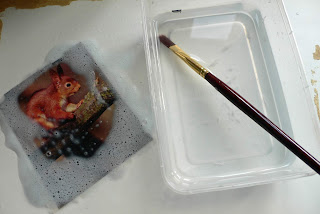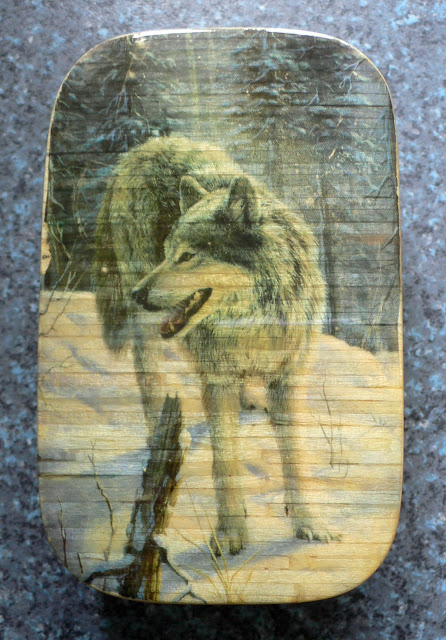Applying a home made transfer to a tin.
In this our second part of our tutorial on home made transfers we come to applying the transfer to the lid of our tin.
The first thing we have to do is to find a blank (a tin with nothing on it) and prepare the blank wooded tin with a couple of coats of varnish. Usually this is done a few days prior to us making the transfer as it takes time for the varnish to dry. One dry the varnish is lightly sanded back with fine wet and dry paper to get a smooth surface. If any lumps or bumps,grit or debris gets behind the transfer when we apply it, this will show. So we need to be quite strict with ourselves when we prepare the tin ready for the transfer to be applied. Keep it dust and dirt free.
 |
| Blank tin varnished and ready for our transfer. |
Below we have our prepared tin with our pot of polyurethane Yacht varnish, a soft brush which will minimise the amount of air bubbles and our transfer still clinging to the food bag. The transfer is still wet at this stage from when we made it.
Because the transfer is still attached to the bag we can handle it easily without too much damage. The next stage we must dry the back of the transfer. Be careful when drying the back of the transfer not to get any dust or pieces of grit etc. on it. The front of the transfer clinging to the food bag should still be wet. This will help us separate the transfer from the food bag.
 |
| Checking the transfer after drying the back before applying to tin. |
The next step once the back of the transfer is dry will be to brush on a layer of varnish to the lid of our tin. This varnish layer will be the glue that holds our transfer to the lid.
 |
| Varnishing the top of the tin lid before adding the transfer. |
Once a coat of varnish has been applied to the lid we then need to carefully move our transfer into place. Luckily the transfer is attached to the food bag so we don't have to touch it directly. Flip the food bag and transfer upside down so that the back of the transfer is now facing the tin lids surface.
 |
| By holding the food bag the transfer is easier to move into place without breakages. |
The photos below shows the transfer has just been applied to the tin lid. Don't worry about the transfer being flat at this stage, as we will work through the process gradually of getting our transfer nice and smooth as we can.
 |
| The food bag still has a role to play in applying the transfer. |
 |
| With the food bag still in place. |
The above photo shows a freshly applied transfer with the food bag attached on top of the transfer. The food bag has one more useful act to perform. The food bag will enable us to attach the transfer by adding pressure with our fingers to press it down.
 |
| Using the food bag we start to smooth pat and tap down the transfer with our fingers. |
Once we are happy with the transfer we simply and carefully peel the bag away leaving the transfer safely attached to out tins lid.
 |
| Peeling back the food bag to expose the transfer. |
We can smooth out the transfer a bit more with our fingers. Remember when handling a transfer and smoothing it out to use water as our fingers have a habit of sticking to the transfer and marking it or accidently dragging it somewhere its not needed. The transfer can also be very stretchy at this point and we do not wish to stretch the transfer as it can easily damage and tear it. The water acts as a lubricant and enables us to work the surface smooth. If there are dips don't be afraid to smooth the transfer into the dip to follow the contours of the wood. These small dips add to the interest of the finished tin and make the item look more hand made.
 |
| Starting to take shape. Now for the air bubbles. |
The above tin shows the transfer beginning to take shape nicely on the lid of the tin. By keep adding water to the transfers surface we are able to manoeuvre it easily into the correct position and smooth out any lumps and bumps. Large air bubbles can be carefully worked along under the transfer and forced out around the edges
 |
| Smoothing out large air bubbles and un-creasing transfer. |
The above picture shows us using a stiff acrylic paint brush to help lay down any folded areas and force further large air bubbles and creases out of the transfer. Once most of the creases and large bubbles are out we need to tackle the small air bubbles.
 |
| After smoothing out the large air bubbles. |
For this job we need little more then a pin.
 |
| Our tool of choice to remove small air bubbles. |
All we do here is burst the bubble with the pin to release the air and with a finger smooth down the area flat. Keep the area you are working on damp so your finger won't drag or mark the transfer.
 |
| The two pictures above shows air bubbles being popped. |
Bursting bubbles can be time consuming but fun. Work in a small area and slowly move out bit by bit to get them all. Try to get as many as you can. The very tiny and microscopic bubbles will probably disappear and shrink when the varnish dries. Once you are happy with the way the transfer is looking place the lid somewhere for the varnish to dry before moving onto the next stage.
 |
| Looking at the edges of the transfer after the varnish has dried. |
After leaving for a day or two to make sure the varnish holding your transfer has totally dried and gone hard we can then start the next process of cleaning up the transfer. Those large overhanging pieces around the edge can now be trimmed back and sanded with fine(400 grit or finer) wet and dry paper to remove them.
 |
| Once the varnish has dried I start to remove the overhanging transfer. |
We can also now safely give the tins lid with the transfer on it a light wet sanding to get rid of any small lumps and bumps we don't want in the varnish with our wet and dry paper. It's surprising just how many small lumps and bumps a light sanding will get rid of. The finished tin will look a lot better for it. Just be careful not to sand too hard as we do not wish to cut through the transfer to bare wood.
 |
| A very light sanding with fine wet and dry removes the last of the uneven surface. |
The above photo shows the tins lid after a light sanding. All we have to do now is give the lid a good varnishing to seal in the transfer and protect it. About two coats between a days drying time should be enough.
 |
| Sealing in the transfer with varnish. |
The above photo shows us varnishing the tins lid to seal in the transfer. The varnish we apply now will also make the colours of the tin come alive and the wood below the transfer should shine through and reflect light back in natural daylight. A most desirable effect.
 |
| The finished lid. |
The lid above has now been finished and once dry is ready to go to it's new owner.
Next weeks tutorial we will be showing you how to apply a wood veneer covering. Wood veneer covered tins opens up a whole new set of possibilities for the tin artist which is not possible with match sticks. Until next week, happy tin crafting.
Don't forget to let us know how you got on with you tin.








































